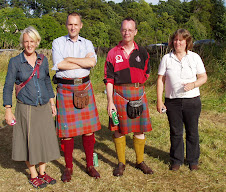Tea it was, and very successful, I think. At first, I thought I had Gone Too Far, and would have to dye the yarn pale brown. But I rinsed the jabot, and it lightened as it dried, and now I think it’s fine. Many thanks.
Having got that far, I spent yesterday’s knitting time on jabot-thinking and indeed jabot-doing. I am less and less confident of my ability to make a suitable object out of a strip of lace, so yesterday I went back to Christine Duchrow. No need to rush things. James can start wearing it (if at all) on St Andrews Night in ’10.
The Duchrow jabot I previously attempted is a single object: that won’t do. We need layers, froths of lace. I found one that looks plausible – a square of lace, attached to the neck at one corner, with a plain rectangle underneath, both edged with the same pretty little edging.
There would be no absolute need to make the rectangle plain, either.
I completely failed to understand the simplest thing about the instructions. You start by casting on two stitches. Alternate rows are plain. Then you begin to increase. One stitch appears at each end of alternate rows. Where do they come from? Reading German, for me, is like trying to view the world through my Retinal-Vein-Occluded eye. It’s there, all right. I can make some sort of sense of it. But I can’t really get to grips with it.
(And actually, I don’t think the notes around the pattern explained the point, anyway. Maybe somewhere else.)
I fiddled around a bit, and found Maureen Egan Emlet’s “Mediterranean Lace” in A Gathering of Lace. I’m attempting four panels from the very bottom of that shawl – again, beginning with two stitches -- only this time I can see where the increases come from. I can’t quite see, at the moment, how I will manage the decreases, when I get to the maximum point. It should theoretically be easy.
It’s a rose trellis lace. I used something like it for the centre of a shawl once. I could do the same for the rectangle. Or try Hazel Carter’s jabot, which started this whole train of thought. That’s a rectangle, and it has a thistle on it, which is a nice touch.
And perhaps go back to Duchrow for the edging. We shall see.
But today I will switch back to the stole, from roses to thistles. Tamar, I think they sort of interlock in a way that won’t (theoretically) allow for another panel in the centre. Starting from each end, the sets of thistles have progressively shorter stems. I thought of adding a whole extra section at each end with stems one step longer than the longest, but decided (laziness?) that that might make it too long altogether.
Non-knit
Every year on Games Day I take pictures of the specimen conifers we have planted down the commonty, with associated grandchildren. This year, we had all the grandchildren and I had the right ones stand by the right tree. I don’t always insist on that. My Drake picture isn’t very good on children, and the Ogdens (London) weren’t there yet so someone else took that one in the evening, and James-the-Younger wasn’t feeling well so that one, too, was repeated in the evening with a different photographer when he was better.
Here’s what I got – Thomas-the-Younger with our deodar, a Himalayan tree. We put it in only recently. It comes from the Ardkinglas nursery, near where they live on Loch Fyne. It's growing fast.
Having got that far, I spent yesterday’s knitting time on jabot-thinking and indeed jabot-doing. I am less and less confident of my ability to make a suitable object out of a strip of lace, so yesterday I went back to Christine Duchrow. No need to rush things. James can start wearing it (if at all) on St Andrews Night in ’10.
The Duchrow jabot I previously attempted is a single object: that won’t do. We need layers, froths of lace. I found one that looks plausible – a square of lace, attached to the neck at one corner, with a plain rectangle underneath, both edged with the same pretty little edging.
There would be no absolute need to make the rectangle plain, either.
I completely failed to understand the simplest thing about the instructions. You start by casting on two stitches. Alternate rows are plain. Then you begin to increase. One stitch appears at each end of alternate rows. Where do they come from? Reading German, for me, is like trying to view the world through my Retinal-Vein-Occluded eye. It’s there, all right. I can make some sort of sense of it. But I can’t really get to grips with it.
(And actually, I don’t think the notes around the pattern explained the point, anyway. Maybe somewhere else.)
I fiddled around a bit, and found Maureen Egan Emlet’s “Mediterranean Lace” in A Gathering of Lace. I’m attempting four panels from the very bottom of that shawl – again, beginning with two stitches -- only this time I can see where the increases come from. I can’t quite see, at the moment, how I will manage the decreases, when I get to the maximum point. It should theoretically be easy.
It’s a rose trellis lace. I used something like it for the centre of a shawl once. I could do the same for the rectangle. Or try Hazel Carter’s jabot, which started this whole train of thought. That’s a rectangle, and it has a thistle on it, which is a nice touch.
And perhaps go back to Duchrow for the edging. We shall see.
But today I will switch back to the stole, from roses to thistles. Tamar, I think they sort of interlock in a way that won’t (theoretically) allow for another panel in the centre. Starting from each end, the sets of thistles have progressively shorter stems. I thought of adding a whole extra section at each end with stems one step longer than the longest, but decided (laziness?) that that might make it too long altogether.
Non-knit
Every year on Games Day I take pictures of the specimen conifers we have planted down the commonty, with associated grandchildren. This year, we had all the grandchildren and I had the right ones stand by the right tree. I don’t always insist on that. My Drake picture isn’t very good on children, and the Ogdens (London) weren’t there yet so someone else took that one in the evening, and James-the-Younger wasn’t feeling well so that one, too, was repeated in the evening with a different photographer when he was better.
Here’s what I got – Thomas-the-Younger with our deodar, a Himalayan tree. We put it in only recently. It comes from the Ardkinglas nursery, near where they live on Loch Fyne. It's growing fast.

And the Beijing Mileses with the metasequoia. That’s a tree which was identified and named from a fossil and later turned up growing peacefully in China. We planted ours when James and Cathy married, and it has struggled in the dry soil of the commonty, but is at last growing faster than the children. You have to peer a bit, but it's there, above Rachel-the-Younger in the middle.





if you need help with translating the pattern, I'll be glad to help, feel free to PM me on ravelry (agaknit)
ReplyDeleteOoh, I love the fact that you have a metasequoia - I never heard of them before - how neat, to have a tree that was thought to be extinct!
ReplyDeleteGood luck with the lace.
There is or used to be a metasequoia near the old post office in Palo Alto, California. When I last passed by there some years ago it seemed to be ailing, which is why I say "used to be". But it had been there for many years, and was fronted by a plaque proclaiming its nature and provenance.
ReplyDelete-- Gretchen
Re the Jabot. Does it have to have froths of lace? And I admit ignorance to the difference between jabots for men and ladies. But this one is a gathered rectangle that looks very sharp:
ReplyDeletehttp://chestofbooks.com/food/household/Woman-Encyclopaedia-1/Needlework-Ideas-For-Making-Jabots-Out-Of-Fancy-Handkerchiefs.html
Then there is this idea:
http://www.tudorlinks.com/treasury/freepatterns/w1907jabot.html
Which would be a centerpiece with a edge ruffle. It wouldn't be any different than a lace shawl except you'd do more edging than edge to make ruffles.
In my head is an idea utilizing round lace doilies. 3 doilies, each one an inch or so larger than the previous. Fold each circle slightly off half, gather along the fold and layer small to large, top to bottom.
Just .02 from across the pond. (My zucchini failed)
I have seen jabots shaped like a large semicircle. Each side is folded in towards the center to meet there, and back out again, multiple times. End result is a tapered rectangle with zigzag layers mirroring each other, ascending towards the top.
ReplyDeleteI really enjoyed the tree (and grandchildren) photos. Off to google metasequoia!
ReplyDeleteLisa in Toronto
p.s. what is a commonty? I can't find a definition today (will check my parents big OED tomorrow).
ReplyDelete